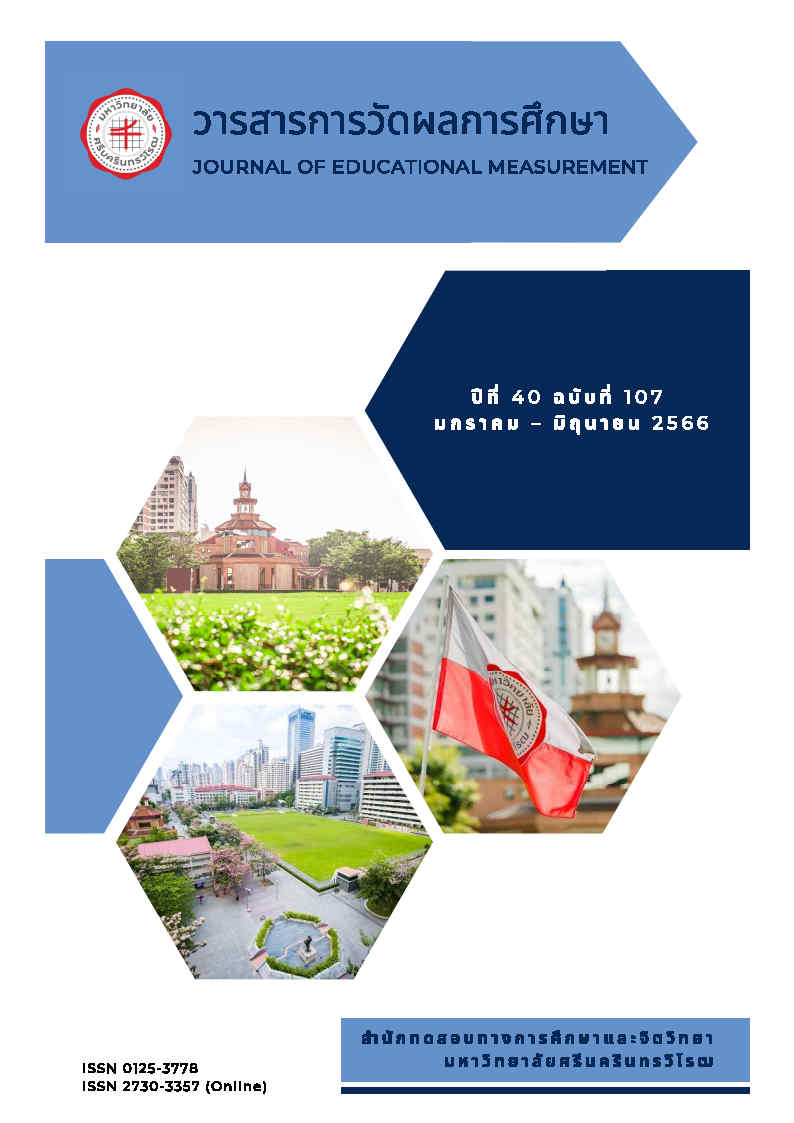Development of Anti-Corruption Scale for Primary Students
Keywords:
Anti – corruption, Situation Test, Confirmatory Factor AnalysisAbstract
This research aimed to develop and find the quality of Anti – corruption scale for primary student. The sample of this research was 720 persons consist of prathomsuksa VI students in Bangkok primary education service area office. The instruments in this research were a socially desirable responding scale and anti – corruption scale for primary student. Analyzing the instruments quality by content validity using Index of item objective congruence (IOC) discrimination using corrected item-total correlation reliability using Cronbach alpha – coefficient and construct validity using confirmatory factor analysis.
findings were:
- The implemented anti – corruption scale consisted of 31 situational multiple – choice question with four choices, with indicators comprising of 4 factors:knowledge and understanding about anti -corruption, self sufficiency mindedness, ashamed of corruption and intolerance to corruption. The anti – corruption scale for primary student has an Index of Item Objective Congruence (IOC from 0.60 – 1.00. The discrimination ranged from 0.10 – 0.54. Item reliability ranged from 0.45 – 0.61 and whole of reliability was 0.80 and after checking for construct validity of the test by confirmatory factor analysis, found that the model of anti – corruption by the researcher conformed with the empirical data (Chi-Square = 35.27 df = 33 p = 0.36 GFI = 0.99 AGFI = 0.98 RMR = 0.01 RMSEA = 0.01).
- The criteria of anti – corruption scale for primary student were developed using the normalized T – score. The overall anti – corruption had raw score between5 – 29 (T21 – T61), knowledge and understanding about anti-corruption had raw score between 0 – 12 (T21 – T72), self sufficiency mindedness had raw score between 0 – 9 (T24 – T67), ashamed of corruption had raw score between 0 – 5 (T29 – T59) and intolerance to corruption had raw score between 0 – 5 (T30 – T65).
References
กันติพิชญ์ ใจบุญ. (2560). "เยาวชนจะหยุดทุจริตชาติ" หวังระยะยาวของ ป.ป.ช.https://www.posttoday.com/politic/report/522961
เกรียงศักดิ์ โชควรกุล.(2561). กลยุทธ์การต่อต้านการทุจริตด้วยการสร้างค่านิยมของกลุ่มนักศึกษาในจังหวัดชัยภูมิ. วารสารมนุษยศาสตร์และสังคมศาสตร์ มหาวิทยาลัยราชภัฏสุรินทร์, 20(2), 248-264.
จารุวรรณ สุขุมาลพงษ์. (2556). แนวโน้มคอร์รัปชั่นในประเทศไทย. สำนักงานเลขาธิการสภาผู้แทนราษฎร.
ณัฏฐภรณ์ หลาวทอง. (2559). การสร้างเครื่องมือการวิจัยทางการศึกษา. จุฬาลงกรณ์มหาวิทยาลัย
ทศวร มณีศรีขำ. (2559). การศึกษาความรู้และเจตคติของนักเรียนประถมศึกษาปีที่ 6 กรุงเทพมหานคร ที่มีต่อหลักสูตร “โตไปไม่โกง”. วารสารวิจัยทางการศึกษา คณะศึกษาศาสตร์ มหาวิทยาลัยศรีนครินทรวิโรฒ, 10(1), 70-78.
บงกช สุทัศน์ ณ อยุธยา. (2557). การสร้างจิตสำนึกของความเป็นไทย ค่านิยม เพื่อการต่อต้านป้องกันการทุจริต คอร์รัปชั่น. วารสารศรีนครินทรวิโรฒวิจัยและพัฒนา (สาขามนุษยศาสตร์และสังคมศาสตร์), 6(11), 248-264.
ราชบัณฑิตยสถาน. (2557). พจนานุกรมฉบับราชบัณฑิตยสถาน พ.ศ. 2554. นานมีบุ๊คส์.
ล้วน สายยศ และอังคณา สายยศ. (2543). เทคนิคการวัดผลการเรียนรู้ (พิมพ์ครั้งที่ 2). ชมรมเด็ก
ศิริชัย กาญจนวาสี. (2556). ทฤษฎีการทดสอบแบบดั้งเดิม (CLASSICAL TEST THEORY) (พิมพ์ครั้งที่ 7). จุฬาลงกรณ์มหาวิทยาลัย
ศุภวัฒนากร วงศ์ธนวสุ และคณะ. (2564). โครงการติดตามและประเมินผลสัมฤทธิ์ของหลักสูตรต้านทุจริตศึกษาประจำปี 2564. https://drive.google.com/file/d/19zzgPs8UO5T5lFTdV0n8r4nGhYV0-jdV/view
สมถวิล วิจิตรวรรณา. (2565) .แบบวัดเชิงสถานการณ์ : ประยุกต์ใช้วัดคุณลักษณะนิสัย. การวัด ประเมินผล สถิติ และ การวิจัยทางสังคมศาสตร์, 3(1), 11-19.
สํานักงานคณะกรรมการป้องกันและปราบปรามการทุจริตแห่งชาติ. (2564). เค้าโครงวิจัยประเมินพฤติกรรมเด็กและเยาวชนไทยที่ยึดมั่นความซื่อสัตย์สุจริต (An Evaluation Research on Thai Youth’s Acting for Honesty and Integrity) และประเมินผลสัมฤทธิ์ในการใช้หลักสูตรต้านทุจริต 2 หลักสูตรและแนวทางเก็บข้อมูล. https://drive.google.com/file/d/1YUuxiNRRxJVGvujFxTK9dQ2ApzrrmW6e/view
สํานักงานคณะกรรมการป้องกันและปราบปรามการทุจริตแห่งชาติและสำนักงานคณะกรรมการการศึกษาขั้นพื้นฐาน.(2561). แผนการจัดการเรียนรู้ “รายวิชาเพิ่มเติม การป้องกันการทุจริต” ระดับชั้นประถมศึกษาปีที่ 6. สํานักงานคณะกรรมการป้องกันและปราบปรามการทุจริตแห่งชาติ.
สํานักงานคณะกรรมการป้องกันและปราบปรามการทุจริตแห่งชาติ. (2561). คู่มือหลักสูตรต้านทุจริตศึกษา หลักสูตรการศึกษาขั้นพื้นฐาน ชุดหลักสูตรต้านทุจริตศึกษา. สํานักงานคณะกรรมการป้องกันและปราบปรามการทุจริตแห่งชาติ.
สำนักงานป้องกันและปราบปรามการทุจริตแห่งชาติ. (2562). พื้นฐานความรู้เกี่ยวกับสถานการณ์การทุจริตและคอร์รัปชั่น.
สํานักงานสถิติแห่งชาติ. (2564). การสำรวจพฤติกรรมที่ยึดมั่นความซื่อสัตย์สุจริตของเด็กและเยาวชนไทย พ.ศ. 2564. สํานักงานสถิติแห่งชาติ.
สุกัญญา จันทวาลย์. (2556). การพัฒนาแบบวัดการตอบตามความปรารถนาของสังคมของนิสิตไทย [วิทยานิพนธ์ปริญญาดุษฎี บัณฑิต, จุฬาลงกรณ์มหาวิทยาลัย].
สุจริตไทย. (2562). หลักสูตรสุจริตไทย สำหรับนักเรียนและนักศึกษา.https://www.thaihonesty.org/
สุริยเดว ทรีปาตี. (2552). ต้นทุนชีวิตเด็กและเยาวชนไทย. แผนงานสุขภาพเด็กและเยาวชน.
Dong, B. & Torgler, B. (2011). Corruption and Social Interaction: Evidence from China. Social Science Research Network.
Hair J.F., Black W.C., Babin B.J., Anderson R.E. & Tatham R.L. (2006). Multivariate data analysis (6th ed.). Pearson Prentice Hall: New Jersey.
Mccusker.R. (2006). Review of anti-corruption strategies. Australia: Australian Government.



